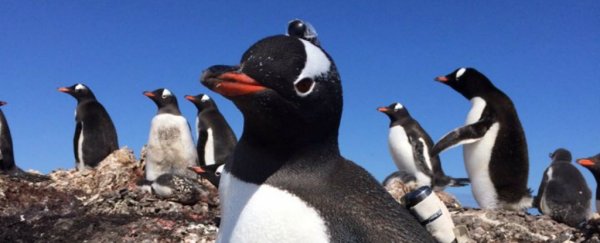For the first time, researchers have amazingly captured the offshore calls of Gentoo penguins as they forage in the freezing waters of the Antarctic Ocean.
Using miniature GoPro-style 'penguincams' fastened to the backs of the seabirds, the team found that vocal communication amongst these penguins is linked to group formation rather than food gathering.
The footage also showed that Gentoo penguins take shorter dives and swim to other areas after making a call, suggesting that their offshore vocalisations may serve a variety of functions.
Speaking to ScienceAlert, researcher Won Young Lee from the Korea Polar Research Institute said that the video footage presents a rare glimpse at the mysterious foraging behaviour of these seabirds.
"Penguins spend a lot of time in the ocean, but how they communicate at sea is poorly understood," said Young Lee. "What surprised us was that they seem to use offshore calls to attract other individuals."
With their neon orange beaks, white-striped heads and pale pink webbed feet, Gentoo penguins (Pygoscelis papua) are hard to miss against the dull colours of the Antarctic landscape.
Standing at around 90cm (35 inches) tall and weighing in at up to 8.5kg (19 pounds) these waddling seabirds are the third largest penguin species in the world.
Like their relatives, the Adélie penguin (Pygoscelis adeliae) and the Little penguin (Eudyptula minor), Gentoo penguins gather in large breeding colonies of up to 300,000 pairs.
And in case these visual characteristics aren't noticeable enough, these penguins also make loud honking calls that sound like a cross between a squeaky toy and a party horn.
But their ear-shattering vocal calls aren't all about bugging the neighbours. Similar to other group living birds, Gentoo penguins rely on a wide variety of vocal signals to exchange information, form groups and coordinate movements.
With all of this in mind, it would be easy to assume these penguins are easy subjects. But researchers have had a hard time figuring out the foraging behaviour of Gentoo penguins as they hunt for krill and fish in the open ocean.
The solution? Strap on a miniature-sized video camera to 26 Gentoo penguins and record their calls when they take a trip out to sea. You can watch some of the footage they captured below:
Over two breeding seasons, Young Lee and colleagues recorded a total of 598 penguin calls off the shores of Antarctica's King George Island.
While playing back the video files, the researchers analysed the acoustics of the offshore calls and examined the penguins' diving, foraging and group behaviour patterns.
They found that almost half of the penguins formed into groups within one minute of sounding a call. Each of the vocalisations varied in its length and frequency, and closely resembled contact calls observed in African penguins (Spheniscus demersus).
Despite foraging in a group, there was no sign of vocal interaction between the penguins. There was also little change in foraging dives or prey capture after an offshore call was made.
This suggests that offshore vocal calls may have more to do with group formation than interacting with neighbours or helping each other forage for food.
When the team examined the video footage, they noticed that the penguins took quick shallow dives after making a vocal call. As making a call costs energy, the shorter dives were likely due to decreased oxygen levels after producing the vocalisation.
And it looks like we can expect to see more penguins shooting videos for our viewing pleasure. Now that researching Gentoo penguin foraging behaviour has become a little more accessible, the team hopes to use the bird-borne cameras to discover more about why they make vocal calls during foraging trips.
"We do not know why these penguins produce calls or how they recognise these calls in the open ocean," Young Lee told ScienceAlert. "We suspect that there are other mechanisms involved in vocal communication."
The research was published in Scientific Reports.
